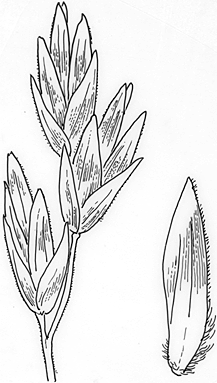Common name: Bog Snow-grass
Poa costiniana Vickery APNI* 
Description: Erect, densely caespitose perennial to 0.8 m high, with intravaginal innovations.
Culms terete or slightly compressed, smooth or very lightly scabrid, moderately slender, 1–2-noded, to c. 80 cm tall. Sheaths smooth to sparsely scabrous; ligule c. 1–3 mm long, firmly membranous, truncate-obtuse; blade convolute and terete or closely folded and compressed, 7–40 cm long, 0.3–1.75 mm wide, mostly smooth, rather rigid.
Inflorescence 5–20 cm long, loosely contracted or at length much spreading and more or less pyramidal. Spikelets 2–5-flowered, compressed but slightly plump, ovate. Glumes acute to shortly acuminate, 1–3(–5)-nerved. Lemmas scabrous above, acute to subacute, 5-nerved, web from moderately well developed to rather scanty, obsolescent or absent; palea scabrous on the upper keels, smooth below.
Flowering: Flowers in summer.
Distribution and occurrence: In alpine or subalpine relict bogs, or bordering streams, or in very wet alpine grassland and extending up into grassland especially at higher altitudes.
NSW subdivisions: NT, ST
Other Australian states: Vic.
Text by Jacobs, S.W.L., Whalley, R.D.B. & Wheeler, D.J.B.
Taxon concept: Grasses of New South Wales, Fourth Edition (2008).
APNI* Provides a link to the Australian Plant Name Index (hosted by the Australian National Botanic Gardens) for comprehensive bibliographic data
***The AVH map option provides a detailed interactive Australia wide distribution map drawn from collections held by all major Australian herbaria participating in the Australian Virtual Herbarium project.
|


